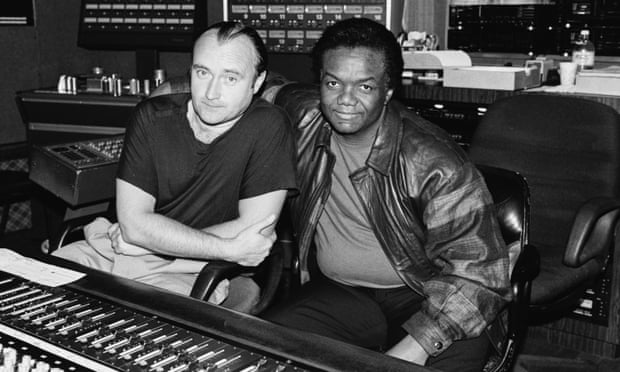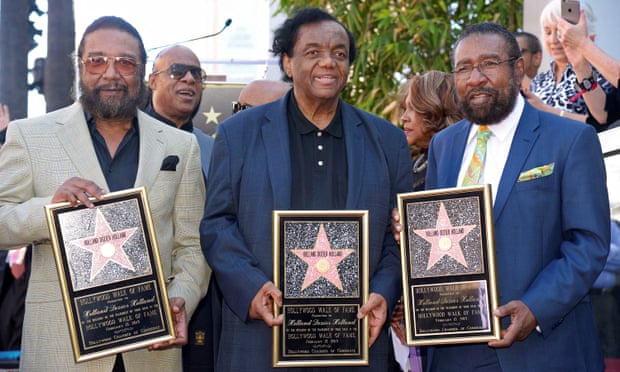Lamont Dozier was 20 years old when his wife, Ann, introduced him to Eddie and Brian Holland one day in 1962. She was packing records and doing typing at the offices of Motown Records in Detroit, where the Holland brothers were among many aspiring songwriters and performers vying to come up with the label’s early hits. Lamont, after mopping the floors at another label while trying to get his singing and writing career off the ground, had taken the offer of $25 a week from Motown’s founder, Berry Gordy Jr, the money to be advanced against future royalties. Once he had struck up a working partnership with the Hollands, the trio wrote and produced million-selling songs that would help define popular music in the 1960s.
Dozier, who has died aged 81, played his part in many of the songs that built the Motown legend and which now seem as impervious to the ravages of time as those of Rodgers and Hart or Lennon and McCartney. Holland-Dozier-Holland classics include heat wave and Nowhere to Run (with Martha and the Vandellas), Can I Get a Witness (Marvin Gaye) Baby I Need Your Loving, I Can’t Help Myself and Reach Out I’ll Be There (Four Tops), This Old Heart of Mine (Isley Brothers), Take Me in Your Arms (Kim Weston) and a record-breaking string of No 1 hits in the US charts for the Supremes, starting with Where Did Our Love Go in 1964 and including Baby Love, Stop! In the Name of Love, You Can’t Hurry Love and You Keep Me Hangin’ On.
Long after their original radio and chart success had faded away, many of Holland-Dozier-Holland’s million-sellers turned out to have embedded themselves so deeply in the public consciousness that they enjoyed second lives, reimagined for new audiences in cover versions by non- Motown artists. Rod Stewart’s This Old Heart of MineKim Wilde’s You Keep Me Hangin’ On and Phil Collins’ You Can’t Hurry Love were among the many reinterpretations that kept a smile on the faces of Holland-Dozier-Holland’s song publishers as the years went by.
Born in Detroit, Lamont was the oldest of the five children of Ethel (nee Waters) and Willie Dozier, whose families had migrated north from Alabama and Georgia. Willie was 21 and Ethel was 14 when they married and settled in Detroit’s Black Bottom district, originally named for its fertile soil. Drafted into the US army soon after Lamont was born, later Willie had trouble holding down a job and it was Ethel who kept the family going with her earnings from cooking and cleaning in suburban homes.
Lamont was educated at Edgar Allan Poe elementary school, where his love of words and poetry began, at Hutchins junior high school, where he met Aretha Franklin, the daughter of a celebrated local Baptist preacher, and at Northwestern high school, where he picked out songs on a piano, already with the idea of a career in music. He was still at school when he and a group of friends formed the Romeos, harmonizing in the doo-wop style and winning the $100 first prize at the Graystone Ballroom’s talent contest.
Dozier wrote and sang lead on the records they made for a label owned by a local businessman. When a song called fine fine baby became a regional hit, Atlantic Records took an interest and gave it a national release. Atlantic’s offer to make further recordings was unwittingly torpedoed by an over-confident 16-year-old Dozier, who insisted that the group would sign only if they could record an entire album straight away.
By that time he had dropped out of high school and was shining shoes on the street to make money. His mother of him, fearing for his future of him, drove him to an army recruiting center, much against his wishes of her. After another car rammed them from behind on an icy road and Dozier’s head hit the dashboard, he arrived for the interview with his clothes soaked in blood from a broken nose and was relieved to be turned down.

The partnership with the Hollands provided him with the focus he needed. After hits on the R&B charts with the Marvelettes and Martha and the Vandellas gave them initial traction, it was with Heat Wave that they found an application for the fervor of gospel within music aimed at teenagers, creating a template for the Motown sound. By contrast, the songs they created for the Supremes traded on a winsomeness that perfectly suited the come-hither style of Diana Ross, the group’s lead singer, tilting soul music in a different direction.
Their most adventurous work was done with the Four Tops, whose act had been slanted towards cabaret performances when Gordy signed them. After the lush romance of Baby I Need Your Loving and Ask the Lonelya song called Reach Out I’ll Be There burst into the world in 1966 with the impact of a Like a Rolling Stone, a Strawberry Fields Forever or a Good Vibrations.
Dozier and Brian Holland had written it together at the piano, shifting the song between major and minor modes, its chant-like lines a conscious amalgam of gospel urgency with Bob Dylan’s phrasing. In the studio, Eddie Holland and the arranger Paul Riser used a piccolo on the introduction, along with timpani mallets on a tambourine head, to achieve what Dozier would describe as “a journey of emotions with sustained tension, like a bolero”. Finally, to turn it into a plea of operatic intensity, they pitched it in a key above the normal range of the group’s great lead singer, Levi Stubbs, forcing him to strain for the notes.

Although the Four Tops were skeptical of its unorthodoxy, it became a No 1 in the US and the UK. And, as always with Holland-Dozier-Holland, there was more where that came from over the subsequent months, in the shape of Standing in the Shadows of Love, Bernadette and 7 Rooms of Gloomeach almost equally remarkable.
When the trio broke away from Gordy over arguments about royalties in the late 60s, they were at the height of their success, wielding sufficient power within the music industry to form their own successful label, Invictus, whose hit artists included the Chairmen of the Board , Freda Payne, and the duo of Holland-Dozier, whose single Why Can’t We Be Lovers, featuring Dozier, became a hit. After the partnership broke up in the early 70s, Dozier summarized his singing career with a series of albums that started with the pointedly titled Out Here on My Own in 1973 and Black Bach the following year. Including the hit singles Trying to Hold on to My Woman and All Cried Outthey demonstrated their ability to create fine music without the assistance of their former collaborators.
In later years he provided songs for Alison Moyet, Debbie Gibson, Peabo Bryson and Regina Belle, wrote with Simply Red’s Mick Hucknall, and worked with Phil Collins on Two Hearts, a hit song from the 1988 film Buster, nominated for an Oscar and recipient of a Grammy award. In 2022 a sample from the swooning ballad I Got It All With You, from his 1979 album Bittersweet, provided the basis for Crazy, a hit for singer Kelly Rowland. He and the Hollands were inducted into the Rock and Roll Hall of Fame in 1990.
Dozier’s first marriage, to Ann Brown, ended in divorce, as did a second, in 1969, to Daphne Dumas. In 1980 he married Barbara Ullman, who died in 2021. He is survived by six children.
www.theguardian.com
George is Digismak’s reported cum editor with 13 years of experience in Journalism